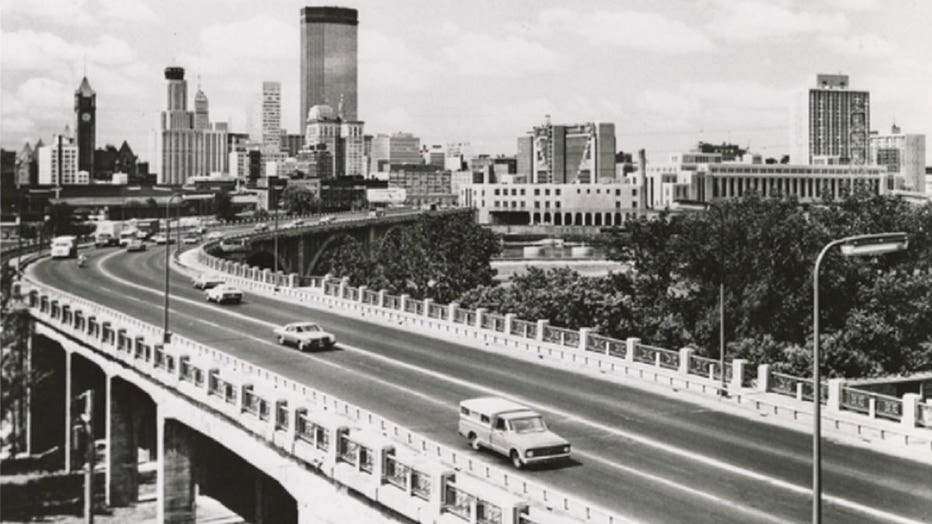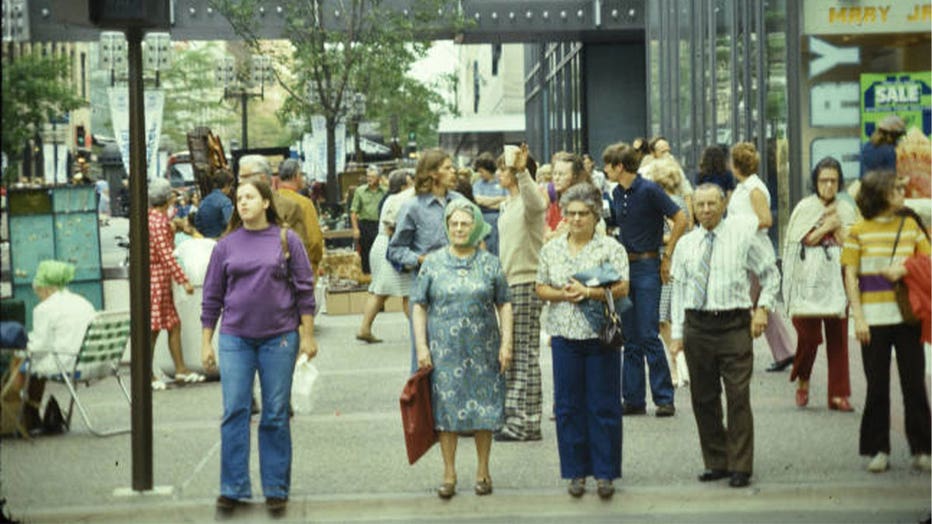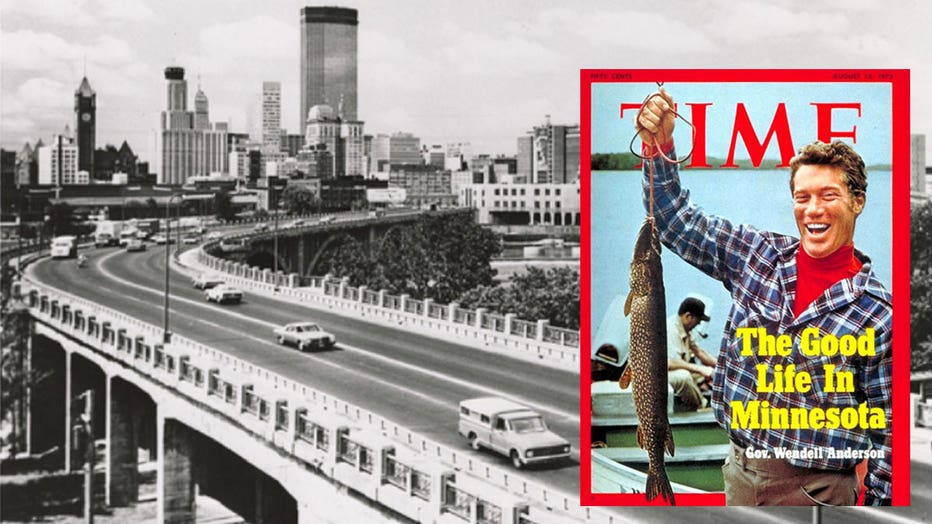Minnesota Untold: An iconic story from Minnesota’s ‘Golden Age’ shows its rust
Minnesota Untold: An iconic story from Minnesota’s ‘Golden Age’ shows its rust
The most telling stories may be the ones we keep telling ourselves, over, and over, again.
MINNEAPOLIS (FOX 9) - The most telling stories may be the ones we keep telling ourselves, over, and over, again.
For nearly 50 years Minnesotans of a certain generation have been embellishing and deconstructing a particular narrative that arrived on newsstands the week of August 13, 1973.
That now infamous Time Magazine story with a fair-haired Governor Wendell (Wendy) Anderson on the cover holding up a pike with pride, with the headline: "The Good Life in Minnesota."
Someone Discovered Us
Chuck Ruhr was an advertising executive living in White Bear Lake when he was interviewed for the piece.
"Fantastic reaction," Ruhr told us recently from near Scottsdale, Arizona, where he now snowbirds. "Someone had finally discovered us," he recalled.
"At that time, in relation to the rest of the country, Minnesota was pretty atypical. Now compared to the rest of the country Minnesota is pretty typical, unfortunately," Ruhr said.
"The average has come up, or we moved down," he chuckled.
Ruhr, it so happens, had done some television advertising work for Governor Anderson’s 1971 campaign.
Anderson had won promising to cut property taxes and dramatically increasing support for K-12 education. And he did it by raising just about every other tax imaginable.
The so-called "Minnesota Miracle" was born.

(Minnesota Historical Society / Supplied)
Well Above Average
Things were certainly looking up in 1973. The recently completed IDS Building dominated the skyline and Nicollet Mall was bustling.
Back then, Minnesota was home to some of the nation’s fastest-growing companies – Honeywell, Control Data, Univac, 3M, General Mills, Hormel, Pillsbury, Northwest Airlines, and Investors Diversified.
Mergers and acquisitions changed the business landscape and today only General Mills, 3M, Hormel, and Investors Diversified (now Ameriprise Financial) remain headquartered in Minnesota.
The high school dropout rate was the lowest in the nation (7.6%) back then, we’ve since slipped to fourth.
Our crime rate was the third lowest in 1973, only Iowa and Maine were lower. Today, Minnesota is ranked 17th.
For some,1973 was peak Minnesota, sealed in a snow globe.
An Enduring Nostalgia
Minnesota’s State Demographer, Susan Bower, was just a toddler in 1973, and is acutely aware of how much Minnesota has changed since then.
She also knows the Time story has an enduring nostalgia for some.
"It gets brought up frequently by a certain generation of people I work with," said Bower.
The context, she said, is usually "those were the days, and we were slipping."
Minnesota is a very different state demographically than it was in 1973, when the state’s population was nearly 4 million and 98% white. Only 2% were people of color.
Beginning in the late 1970s, Minnesota’s demographics began to change with a wave of immigrants and refugees. First, the Hmong and Vietnamese (1970s) followed by Mexicans and Latin Americans (1990s), and people from Somalia and East Africa (2000s).
But Bower said it is actually those first-generation immigrants’ children and grandchildren – with higher birth rates – who are driving Minnesota’s demographics.
Today, 24% of Minnesotans are people of color, according to data from the 2020 U.S. Census. And by 2050, the Twin Cities metropolitan region won’t have a racial majority.

(Hennepin County Library Archives / Supplied)
With ‘baby boomers’ leaving the job market, the demographics suggest it is young people of color who will become Minnesota’s economic engine of the future.
"We had it all in 1973 let’s say, or at least it looked as if we did," Bower said.
"As we became more diverse our diverse population didn’t share in that good fortune of education attainment, access to the same skills the rest of us have had for generations," she said.
Asked if that is a sign of structural racism, Bower did not hesitate.
"I will absolutely say that’s the case," she said.
Chronic Racial Disparities
Minnesota used to pride itself on being, like Garrison Keillor’s fictional Lake Wobegon, a place "where "all the women are strong, all the men are good-looking, and all the children were above average."
Today, Minnesota has some of the largest racial disparities in the nation.
The median income for whites is $80,000, about $33,000 more than African Americans.
Only 7% of whites live below the poverty line while for people of color it is one out of five.
When it comes to homeownership, a key factor for building and transmitting generational wealth, Minnesota has the largest racial gap in the nation. At least 77% of white people own their own homes, but for people of color, it drops to 44%.
And when it comes to high school graduation rates, 88% of white students in Minnesota will graduate in four years, but for Black and Latin X students it's around 70%.

(Hennepin County Library Archives / Supplied)
A Cover for White Denial
The 1973 Time story touches on race relations in Minnesota when it notes that "blacks rioted in Minneapolis in 1966 and 1967, but with 1% of the population, they have not yet forced Minnesotans into any serious racial confrontation. Or at least, not an apocalyptic confrontation."
The comment would prove prescient nearly 50 years later when the murder of George Floyd by Minneapolis Police set of weeks of civil unrest.
University of St. Thomas history professor Yohuru Williams, the co-founder of the university’s Racial Justice Initiative, touched on the significance of that old Time story when discussing "the kindling" that fueled the civil unrest.
"The ‘Good Life in Minnesota’ didn’t extend to all segments of this population, certainly not to African Americans, certainly not to Native Americans," Williams said.
"By 2020, when we're looking at what's taking place on the landscape in Minneapolis, it's a replay of not having dealt with those issues in a substantive way. It is, again, this kind of revisiting of these challenges we associate with racial inequality in America," Williams continued.
Losing Yourself in Utopia
That ambivalence is even foreshadowed in the Time story.
Richard Paulson, an orthodontist, is quoted as saying, "You can lose yourself in this utopia. It’s so easy not to be confronted by the needs of others."
Even the author of that time story, Lance Morrow, wondered in an update for the Wall Street Journal, "How Minnesota went from Tom Sawyer to Huck Finn," to "become a microcosm of an America in crisis."
Morrow declined to comment for this story, writing in an email that he doesn’t know much about what’s happening in Minnesota now.
But the Camelot depicted in August 1973 didn’t last long. Just a couple of months after that Time hit newsstands, the Minnesota Miracle, and the rest of the nation hit a snag. OPEC imposed its oil embargo, gas prices quadrupled, and inflation took off like a rocket. The country was in a full-blown recession.
Chuck Ruhr got the final quote in that Time story.
"California is the flashy blond you want to take out once or twice. Minnesota is the girl you want to marry."
Asked if he’d still ‘marry’ Minnesota, Ruhr didn’t hesitate.
"Yes, it’s a different place. It’s a different girl now. But I still would."

(Minnesota Historical Society/Time Magazine)

